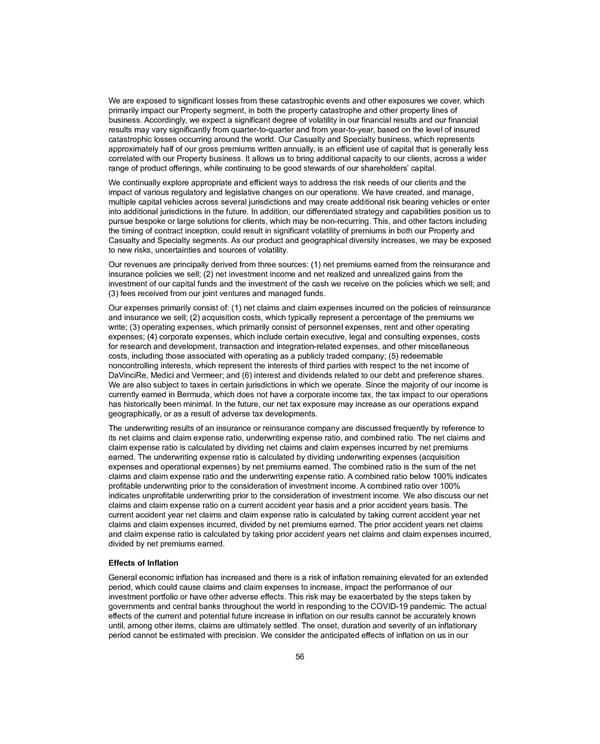We are exposed to significant losses from these catastrophic events and other exposures we cover, which primarily impact our Property segment, in both the property catastrophe and other property lines of business. Accordingly, we expect a significant degree of volatility in our financial results and our financial results may vary significantly from quarter-to-quarter and from year-to-year, based on the level of insured catastrophic losses occurring around the world. Our Casualty and Specialty business, which represents approximately half of our gross premiums written annually, is an efficient use of capital that is generally less correlated with our Property business. It allows us to bring additional capacity to our clients, across a wider range of product offerings, while continuing to be good stewards of our shareholders’ capital. We continually explore appropriate and efficient ways to address the risk needs of our clients and the impact of various regulatory and legislative changes on our operations. We have created, and manage, multiple capital vehicles across several jurisdictions and may create additional risk bearing vehicles or enter into additional jurisdictions in the future. In addition, our differentiated strategy and capabilities position us to pursue bespoke or large solutions for clients, which may be non-recurring. This, and other factors including the timing of contract inception, could result in significant volatility of premiums in both our Property and Casualty and Specialty segments. As our product and geographical diversity increases, we may be exposed to new risks, uncertainties and sources of volatility. Our revenues are principally derived from three sources: (1) net premiums earned from the reinsurance and insurance policies we sell; (2) net investment income and net realized and unrealized gains from the investment of our capital funds and the investment of the cash we receive on the policies which we sell; and (3) fees received from our joint ventures and managed funds. Our expenses primarily consist of: (1) net claims and claim expenses incurred on the policies of reinsurance and insurance we sell; (2) acquisition costs, which typically represent a percentage of the premiums we write; (3) operating expenses, which primarily consist of personnel expenses, rent and other operating expenses; (4) corporate expenses, which include certain executive, legal and consulting expenses, costs for research and development, transaction and integration-related expenses, and other miscellaneous costs, including those associated with operating as a publicly traded company; (5) redeemable noncontrolling interests, which represent the interests of third parties with respect to the net income of DaVinciRe, Medici and Vermeer; and (6) interest and dividends related to our debt and preference shares. We are also subject to taxes in certain jurisdictions in which we operate. Since the majority of our income is currently earned in Bermuda, which does not have a corporate income tax, the tax impact to our operations has historically been minimal. In the future, our net tax exposure may increase as our operations expand geographically, or as a result of adverse tax developments. The underwriting results of an insurance or reinsurance company are discussed frequently by reference to its net claims and claim expense ratio, underwriting expense ratio, and combined ratio. The net claims and claim expense ratio is calculated by dividing net claims and claim expenses incurred by net premiums earned. The underwriting expense ratio is calculated by dividing underwriting expenses (acquisition expenses and operational expenses) by net premiums earned. The combined ratio is the sum of the net claims and claim expense ratio and the underwriting expense ratio. A combined ratio below 100% indicates profitable underwriting prior to the consideration of investment income. A combined ratio over 100% indicates unprofitable underwriting prior to the consideration of investment income. We also discuss our net claims and claim expense ratio on a current accident year basis and a prior accident years basis. The current accident year net claims and claim expense ratio is calculated by taking current accident year net claims and claim expenses incurred, divided by net premiums earned. The prior accident years net claims and claim expense ratio is calculated by taking prior accident years net claims and claim expenses incurred, divided by net premiums earned. Effects of Inflation General economic inflation has increased and there is a risk of inflation remaining elevated for an extended period, which could cause claims and claim expenses to increase, impact the performance of our investment portfolio or have other adverse effects. This risk may be exacerbated by the steps taken by governments and central banks throughout the world in responding to the COVID-19 pandemic. The actual effects of the current and potential future increase in inflation on our results cannot be accurately known until, among other items, claims are ultimately settled. The onset, duration and severity of an inflationary period cannot be estimated with precision. We consider the anticipated effects of inflation on us in our 56
 2021 Annual Report Page 71 Page 73
2021 Annual Report Page 71 Page 73